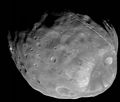Fájl:Phobos colour 2008.jpg

Az előnézet mérete: 636 × 600 képpont További felbontások: 255 × 240 képpont | 509 × 480 képpont | 815 × 768 képpont | 1 086 × 1 024 képpont | 2 172 × 2 048 képpont | 3 500 × 3 300 képpont.
Eredeti fájl (3 500 × 3 300 képpont, fájlméret: 2,72 MB, MIME-típus: image/jpeg)
Fájltörténet
Kattints egy időpontra, hogy a fájl akkori állapotát láthasd.
| Dátum/idő | Bélyegkép | Felbontás | Feltöltő | Megjegyzés | |
|---|---|---|---|---|---|
| aktuális | 2018. április 2., 05:10 |  | 3 500 × 3 300 (2,72 MB) | Kaldari | more margin on right side |
| 2008. november 13., 06:47 |  | 3 374 × 3 300 (2,7 MB) | Fir0002 | == Summary == {{Information |Description=Colour image of Phobos, imaged by the Mars Reconnaisance Orbiter in 2008 |Source=NASA |Date=9 April 2008 |Location=http://www.nasa.gov/mission_pages/MRO/multimedia/pia10368.html |Author=NASA/J |
Fájlhasználat
Az alábbi lapok használják ezt a fájlt:
Globális fájlhasználat
A következő wikik használják ezt a fájlt:
- Használata itt: af.wikipedia.org
- Használata itt: an.wikipedia.org
- Használata itt: ar.wikipedia.org
- المريخ
- فوبوس
- قمرا المريخ
- ويكيبيديا:صور مختارة/الفضاء والكون/نظرة إلى الأعلى
- قائمة أجرام المجموعة الشمسية مرتبة حسب الحجم
- بوابة:علم الفلك/صورة مختارة
- بوابة:المريخ/مقالة مختارة/أرشيف
- بوابة:المريخ/مقالة مختارة/2
- قائمة الأقمار الطبيعية
- خط زمني لاكتشاف كواكب المجموعة الشمسية وأقمارها
- ويكيبيديا:ترشيحات الصور المختارة/القمر فوبوس
- ويكيبيديا:صورة اليوم المختارة/أغسطس 2019
- قالب:صورة اليوم المختارة/2019-08-03
- بوابة:علم الفلك/صورة مختارة/73
- معسكر قاعدة المريخ
- ويكيبيديا:صورة اليوم المختارة/يناير 2022
- قالب:صورة اليوم المختارة/2022-01-04
- Használata itt: ary.wikipedia.org
- Használata itt: arz.wikipedia.org
- Használata itt: as.wikipedia.org
- Használata itt: azb.wikipedia.org
- Használata itt: az.wikipedia.org
- Használata itt: be-tarask.wikipedia.org
- Használata itt: be.wikipedia.org
- Használata itt: bg.wikipedia.org
- Használata itt: bh.wikipedia.org
- Használata itt: bn.wikipedia.org
- Használata itt: bn.wikibooks.org
- Használata itt: bs.wikipedia.org
A fájl globális használatának megtekintése





